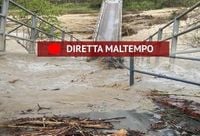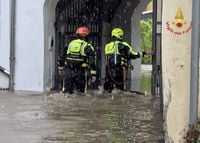On April 17, 2025, the weather situation in the northwest of Italy, particularly in the regions of Piedmont and Aosta Valley, has reached a critical level due to severe flooding and heavy rainfall. The ongoing weather event has resulted in one confirmed casualty and significant infrastructural damage.
Heavy rainfall in Piedmont has led to accumulations of 400-500mm in some areas, particularly in the provinces of Vercelli and Biella. The intensity of the precipitation has caused rivers and streams to overflow, resulting in widespread flooding, landslides, and evacuations across multiple municipalities.
In Monteu da Po, located in the Chivassese area, an elderly man tragically lost his life after being trapped in his flooded home. The floodwaters have rendered the entire area isolated, complicating rescue efforts. Reports indicate that the Messa stream overflowed between Albese, Rubiana, and Villar Dora, causing water to inundate homes in these communities.
Authorities have reported similar flooding incidents in Chivasso, Avigliana, and Collegno, among other towns in the Canavese region. The situation is particularly dire in the Valsesia area, where numerous landslides have been documented, prompting evacuations and the closure of several roads and bridges.
Rainfall has been relentless, with some regions experiencing 300-400mm of rain in just 36 hours, which is at least double the average rainfall for the entire month of April. The snow line has dropped to below 1500m, which has helped mitigate some of the potential flood damage by converting rain into snow at higher elevations. However, this shift has also raised concerns about future flooding as the snow melts.
In Aosta Valley, snowfall has been substantial, with accumulations reaching up to 1 meter above 1900-2000m and over half a meter at lower elevations. The heavy snow has led to power outages and isolated villages, particularly in the central-eastern part of the region. The rising temperatures and heavy precipitation have created a risk of avalanches, particularly in both Aosta Valley and the medium-high regions of Piedmont.
As of 9:40 AM, authorities in Turin closed the Murazzi along the Po River as a precautionary measure due to rising water levels, which, although still below critical levels, are on the rise. Road closures have been reported in several areas including Almese, Bricherasio, Buriasco, and others, complicating travel and emergency response efforts.
In the southeastern Aosta Valley, rainfall accumulations have approached 500mm, causing the Dora River to swell dangerously. Flooding in Fontainemore has led to additional road closures, and the situation remains precarious as local authorities continue to monitor the water levels closely.
The emergency response has been extensive, with over 400 firefighters deployed in the region, and additional reinforcements arriving from Tuscany. The Civil Protection Department has activated 181 municipal operational centers to coordinate rescue efforts and manage the crisis effectively.
President of the Piedmont Region, Alberto Cirio, has been actively involved in overseeing the emergency response. He noted, “We have some critical situations, especially for landslides and floods. In Borgosesia, 150 people were evacuated as a precaution, and another 40 in Villadossola are being assisted by our volunteers.”
Despite the ongoing challenges, there have been some signs of improvement. The flood wave of the Stura di Lanzo river has passed, and the hydrometric levels are beginning to decrease in the Turin area. However, significant damage has been reported, including the erosion of the central pillar of the Villanova Canavese bridge, which will likely remain closed for several days for safety inspections.
As the situation continues to develop, residents are urged to remain vigilant and heed warnings from local authorities. The forecast indicates that heavy rain will persist throughout the day, with the potential for further flooding, particularly in the alpine and pre-alpine sectors.
The intense weather system affecting the region has been linked to an extratropical cyclone, which has drawn in moist air from the Mediterranean, exacerbating the rainfall. While some areas may see a reduction in precipitation by the evening, the overall outlook remains concerning as more rain is expected.
In light of the ongoing emergency, local officials have emphasized the importance of community preparedness and response. With many roads impassable and several regions isolated, the collaboration between emergency services and the local population is crucial in navigating this challenging situation.
The situation in Piedmont and Aosta Valley serves as a stark reminder of the impacts of severe weather events and the importance of effective emergency management and community resilience in the face of natural disasters.






